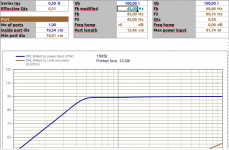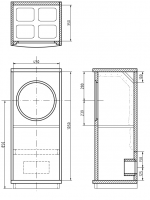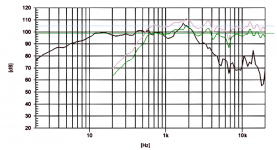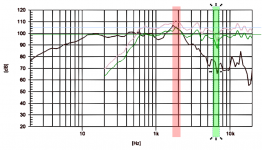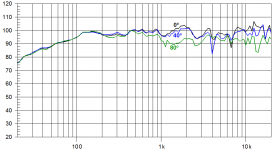Hi!
I've just found out that I have two different seemingly official spec-sheets of the Beyma 15XA38ND - and they are fairly different!
One has fs at 33Hz, the other at 38Hz! Which is correct???
The rest of the TSP are different too, and so are the response curves!
Cheers
Es
I've just found out that I have two different seemingly official spec-sheets of the Beyma 15XA38ND - and they are fairly different!
One has fs at 33Hz, the other at 38Hz! Which is correct???
The rest of the TSP are different too, and so are the response curves!
Cheers
Es
Hi guys,
hope you are all in good health!
I actually went and bought a set of Beymas new on eBay - directly from Spain. The vendor seemed very happy to do business in the middle of the Corona situation, and the price was very good! Got the standard Beyma crossovers more or less thrown in, which will be good for getting the speakers up and running.
I am still very undecided as to what style of enclosure to build - I am very torn between Arden-style, Glenair-style and Onken-style.
The speakers have to sit fairly close to the wall, which makes me want to explore designs with the ports in front, and I think width-wise I'm limited to about 50cm...
Ideally, I'd want the centre of the driver at ear-height, which speaks for a tall enclosure!
The wife has asked if they will be "bigger" than the existing speakers
Stay healthy!
Es
hope you are all in good health!
I actually went and bought a set of Beymas new on eBay - directly from Spain. The vendor seemed very happy to do business in the middle of the Corona situation, and the price was very good! Got the standard Beyma crossovers more or less thrown in, which will be good for getting the speakers up and running.
I am still very undecided as to what style of enclosure to build - I am very torn between Arden-style, Glenair-style and Onken-style.
The speakers have to sit fairly close to the wall, which makes me want to explore designs with the ports in front, and I think width-wise I'm limited to about 50cm...
Ideally, I'd want the centre of the driver at ear-height, which speaks for a tall enclosure!
The wife has asked if they will be "bigger" than the existing speakers
Stay healthy!
Es
So how did it go?
Hopefully you didn't show the drawings/dimensions to the wife beforehand
Any first impressions?
Hopefully you didn't show the drawings/dimensions to the wife beforehand
Any first impressions?
Hi guys,
hope you are all in good health!
I actually went and bought a set of Beymas new on eBay - directly from Spain. The vendor seemed very happy to do business in the middle of the Corona situation, and the price was very good! Got the standard Beyma crossovers more or less thrown in, which will be good for getting the speakers up and running.
I am still very undecided as to what style of enclosure to build - I am very torn between Arden-style, Glenair-style and Onken-style.
The speakers have to sit fairly close to the wall, which makes me want to explore designs with the ports in front, and I think width-wise I'm limited to about 50cm...
Ideally, I'd want the centre of the driver at ear-height, which speaks for a tall enclosure!
The wife has asked if they will be "bigger" than the existing speakers
Stay healthy!
Es
Hi!
I am making progress, be it somewhat slowly!
I decided on the Onken concept and did some simulation to determine the layout of the box.
I've used 30mm beech plywood for the outside panels and 18mm for the inside and bracing.
I can't post pictures right now, as I'm on a business trip!
Cheers
Es
I am making progress, be it somewhat slowly!
I decided on the Onken concept and did some simulation to determine the layout of the box.
I've used 30mm beech plywood for the outside panels and 18mm for the inside and bracing.
I can't post pictures right now, as I'm on a business trip!
Cheers
Es
Howdy,
Wondering if someone with WinISD can help me with calculating port length for my Tannoy Cornetta scaled-up build with these Beyma's. I don't currently have a windows computer to run the software.
Volume = 340L (conservative estimate; actual space without accounting for bracing etc. is 0.3895 m^3)
Slotted port size = 235x145mm or 9.25"x5.71"
Port length = 24mm (thickness of baffle)
See below for style of port that the original 10 or 12" tannoy version was built with. What I'm trying to figure out using, using the Beyma driver specs, is what length to make the rectangular port like this one ->
https://images.hifido.co.jp/10/596/59639/d.jpg
Thanks in advance...
Wondering if someone with WinISD can help me with calculating port length for my Tannoy Cornetta scaled-up build with these Beyma's. I don't currently have a windows computer to run the software.
Volume = 340L (conservative estimate; actual space without accounting for bracing etc. is 0.3895 m^3)
Slotted port size = 235x145mm or 9.25"x5.71"
Port length = 24mm (thickness of baffle)
See below for style of port that the original 10 or 12" tannoy version was built with. What I'm trying to figure out using, using the Beyma driver specs, is what length to make the rectangular port like this one ->
https://images.hifido.co.jp/10/596/59639/d.jpg
Thanks in advance...
Beyma 15XA38Nd Bass Reflex project
Hello guys!
After reading a lot of very interesting information on this driver, I pulled the trigger and bought a pair.
Thanks for the very useul information. I'm not exactly new to this, but not very active on forums. I've build myself some projects, including one transmission line which I enjoyed for 10 years, but it's time for an upgrade.
I considered a few options, but it seems this driver is a really good fit for a traditional relatively big bass reflex. Maybe an MLTL could be an option (Caveman), but I don't have the knowledge or the correct tools to simulate it. Do you see any real advantages for this specific driver, when comparing to a traditional bass reflex?
160L seems to be my sweet spot in terms of size and flat response.
Aligning the enclosure @45Hz, I'm getting F3=45Hz, F6=40Hz (maybe room gain is my friend here? I could not find anything conclusive on room gain...).
Being myself a bit of a bass head, i'm worried about the low end. Maybe it will extend a bit when the enclosure is properly stuffed.
I'm using the spreadsheet recommended by Troels Gravesen in his site.
Port Calculation
Recommendation is to reduce the length of the port by a factor of 0.7, but this is an approximation, as "virtual volume" can change once you add internal stuffing. So maybe I'm able to tune it lower than my simulation, but then there's another question:
Beyma states in the speaker spec sheet that parameters are measured after "some time in operation", which means I need to play for some time before fine adjusting the port length. Any idea on how long (should I run them for the traditional 100 hours before making adjustments?)
Finally, the crossover is the most puzzling piece for me.
Looking at the impedance and response curves, it seems 1200Hz can be a good crossover point, as it is roughly 2x the tweeter Fs, and both drivers show a dip in that region.
Hence, 2nd order Butterworth @ 1200Hz can be an interesting solution.
I used this online application to calculate values (pdf with results attached): 2-Way Crossover Calculator / Designer
Not sure if it's accurate, so if you guys know about more reliable calculators, please, let me know.
Beyma uses a zobel for the woofer in their crossover. Problem is calculated values differ a lot, even if you use the old speaker version parameters. Beyma crossover mentioned here: Beyma 15XA38Nd network
I used this calculator to check
Speaker Zobel / Impedance Equalization Network Circuit Calculator
Using Re 6.7 and Le 1.0mH, as per specs, I'm getting a very similar resistor (8.375 ohms), but the capacitor is quite different (14.25uF, instead of 8.2uF shown on Beyma's crossover).
Am I right to assume the Zobel network should not change if crossover changes? As far as I understood, it's function is precisely to make the speaker impedance "constant" to the preceding crossover, right?
(note: I measured the actual speakers, and their DC resistance is almost exactly the same as their spec: 6.6-6.7 ohm for the woofer)
For the tests, I'm considering buying this:
Dayton Audio DATS V3 Computer Based Speaker & Audio Component Test System
Any experience?
Sorry for the long message, but it is a result of a long process.
Enjoy the sketch of the box attached. Any comments are welcome!!
Cheers!
Hello guys!
After reading a lot of very interesting information on this driver, I pulled the trigger and bought a pair.
Thanks for the very useul information. I'm not exactly new to this, but not very active on forums. I've build myself some projects, including one transmission line which I enjoyed for 10 years, but it's time for an upgrade.
I considered a few options, but it seems this driver is a really good fit for a traditional relatively big bass reflex. Maybe an MLTL could be an option (Caveman), but I don't have the knowledge or the correct tools to simulate it. Do you see any real advantages for this specific driver, when comparing to a traditional bass reflex?
160L seems to be my sweet spot in terms of size and flat response.
Aligning the enclosure @45Hz, I'm getting F3=45Hz, F6=40Hz (maybe room gain is my friend here? I could not find anything conclusive on room gain...).
Being myself a bit of a bass head, i'm worried about the low end. Maybe it will extend a bit when the enclosure is properly stuffed.
I'm using the spreadsheet recommended by Troels Gravesen in his site.
Port Calculation
Recommendation is to reduce the length of the port by a factor of 0.7, but this is an approximation, as "virtual volume" can change once you add internal stuffing. So maybe I'm able to tune it lower than my simulation, but then there's another question:
Beyma states in the speaker spec sheet that parameters are measured after "some time in operation", which means I need to play for some time before fine adjusting the port length. Any idea on how long (should I run them for the traditional 100 hours before making adjustments?)
Finally, the crossover is the most puzzling piece for me.
Looking at the impedance and response curves, it seems 1200Hz can be a good crossover point, as it is roughly 2x the tweeter Fs, and both drivers show a dip in that region.
Hence, 2nd order Butterworth @ 1200Hz can be an interesting solution.
I used this online application to calculate values (pdf with results attached): 2-Way Crossover Calculator / Designer
Not sure if it's accurate, so if you guys know about more reliable calculators, please, let me know.
Beyma uses a zobel for the woofer in their crossover. Problem is calculated values differ a lot, even if you use the old speaker version parameters. Beyma crossover mentioned here: Beyma 15XA38Nd network
I used this calculator to check
Speaker Zobel / Impedance Equalization Network Circuit Calculator
Using Re 6.7 and Le 1.0mH, as per specs, I'm getting a very similar resistor (8.375 ohms), but the capacitor is quite different (14.25uF, instead of 8.2uF shown on Beyma's crossover).
Am I right to assume the Zobel network should not change if crossover changes? As far as I understood, it's function is precisely to make the speaker impedance "constant" to the preceding crossover, right?
(note: I measured the actual speakers, and their DC resistance is almost exactly the same as their spec: 6.6-6.7 ohm for the woofer)
For the tests, I'm considering buying this:
Dayton Audio DATS V3 Computer Based Speaker & Audio Component Test System
Any experience?
Sorry for the long message, but it is a result of a long process.
Enjoy the sketch of the box attached. Any comments are welcome!!
Cheers!
Attachments
Some additional information
Some additional information on the project:
Materials
- Wood: Birch Plywood (if I manage to find it here... )
)
- Wall Thickness:
30mm Front baffle and back
20mm lateral and bracing (theres a piece inbetween the woofer and port which did not appear in the cut lateral view, I don't know why)
- Stuffing:
50mm thicknes PET acoustic treatment plate (around 30kg/m3) behind the speakers
- Automotive felt lining for lateral walls and other surfaces, except for port, and maybe front baffle - this is easy to glue to surfaces and it's designed to reduce vibrations in cars, I've heard good comments about it.
Cables & Connectors
- Belden 9497 - tin plated, seems to be a good choice for the kind of terminals the Beymas have. As you may know, this is recommended by Shindo.
I tested this cable in another installation I have, and it's possible to get marginally better performance when comparing to Mogami W3082 coax studio cable.
- 4 pole Speakon jacks - Neutrik contacts are silver plated, which is more conductive than gold. Besides being very well engineered, makes an easy connection and provides some protection against corrosion, since I leave close to the sea and this is a problem I see in all my connectors. Besides, I'm tired of buying supposedly gold plated terminals just to see them tarnish in the following months.
- 4pole connector will allow me electrical access to individual drivers from outside, for easy external crossover adjusting and bi-amping in the future
- Even after biamping, I'll keep the passive crossovers around as I like to have some true mono playback sometimes, and it sounds gorgeous through a single Revox 59E tube amp.
- Anyway, bi-amping opens up an extensive list of possibilities I want to try in the future.
Assembly
- 2 pairs of high capacity castors behind the bottom skirt, two fixed in the front, two with brakes in the back. This will make it easy to move the monsters around for cleaning and near field listening. I'll add 3 feet (one in the front, two in the back) in a way they remain hidden when moving, and will allow for a fixed installation when I find the right position)
- The only part which will be removable will be the upper back panel, in order to give me internal access to make adjustments after installation
- Some sort of adjustment method to the port in the back: I decided for back firing port for two reasons:
a. It reduces interferences from any mid-range material that could come out if it was positioned in the front
b. My room has thick absorbing material behind the speakers, which will reduce interaction with the room
By the way, I agree this is a multi-way, but highly related to full range.
I'm coming from a full-range experience (Audio Nirvana Classic Super-8), but, at least in my experience and budget , full ranges tend to be naturally limited in frequency extension, even though mid range is beautiful.
, full ranges tend to be naturally limited in frequency extension, even though mid range is beautiful.
Going coax seemed to be a good compromise, let's see how it goes in practice, but point source and high efficiency are two elements I definitely want in my system.
Let's squeeze all that juice from those amazing low power tube amps!!
Some additional information on the project:
Materials
- Wood: Birch Plywood (if I manage to find it here...
- Wall Thickness:
30mm Front baffle and back
20mm lateral and bracing (theres a piece inbetween the woofer and port which did not appear in the cut lateral view, I don't know why)
- Stuffing:
50mm thicknes PET acoustic treatment plate (around 30kg/m3) behind the speakers
- Automotive felt lining for lateral walls and other surfaces, except for port, and maybe front baffle - this is easy to glue to surfaces and it's designed to reduce vibrations in cars, I've heard good comments about it.
Cables & Connectors
- Belden 9497 - tin plated, seems to be a good choice for the kind of terminals the Beymas have. As you may know, this is recommended by Shindo.
I tested this cable in another installation I have, and it's possible to get marginally better performance when comparing to Mogami W3082 coax studio cable.
- 4 pole Speakon jacks - Neutrik contacts are silver plated, which is more conductive than gold. Besides being very well engineered, makes an easy connection and provides some protection against corrosion, since I leave close to the sea and this is a problem I see in all my connectors. Besides, I'm tired of buying supposedly gold plated terminals just to see them tarnish in the following months.
- 4pole connector will allow me electrical access to individual drivers from outside, for easy external crossover adjusting and bi-amping in the future
- Even after biamping, I'll keep the passive crossovers around as I like to have some true mono playback sometimes, and it sounds gorgeous through a single Revox 59E tube amp.
- Anyway, bi-amping opens up an extensive list of possibilities I want to try in the future.
Assembly
- 2 pairs of high capacity castors behind the bottom skirt, two fixed in the front, two with brakes in the back. This will make it easy to move the monsters around for cleaning and near field listening. I'll add 3 feet (one in the front, two in the back) in a way they remain hidden when moving, and will allow for a fixed installation when I find the right position)
- The only part which will be removable will be the upper back panel, in order to give me internal access to make adjustments after installation
- Some sort of adjustment method to the port in the back: I decided for back firing port for two reasons:
a. It reduces interferences from any mid-range material that could come out if it was positioned in the front
b. My room has thick absorbing material behind the speakers, which will reduce interaction with the room
By the way, I agree this is a multi-way, but highly related to full range.
I'm coming from a full-range experience (Audio Nirvana Classic Super-8), but, at least in my experience and budget
Going coax seemed to be a good compromise, let's see how it goes in practice, but point source and high efficiency are two elements I definitely want in my system.
Let's squeeze all that juice from those amazing low power tube amps!!
Crossover design
Moving ahead with crossover design.
My intention is to include an rotary switch + L-Pads to attenuate the tweeter.
I'm targeting 5 positions, being:
+4.5dB
+3.0dB
+1.5dB
Ballanced
-1.5dB
-3.0dB
-4.5dB
The "Balanced" position is the necessary attenuation to get both drivers having the same average SPL output.
According to the manufacturer, that would be -6dB (tweeter is 105dB/W/m and woofer is 99dB/W/m).
I took both drivers response and moved the tweeter response 6dB down, to see how overall response would theoretically be, considering specs are accurate and average is sensible.
Legend
- Red is the tweeter response with no attenuation
- Green is 6dB attenuation
- Horizontal blue is tweeter average sensitivity with no attenuation
- Horizontal green is tweeter average sensitivity attenuated
Looks good.
Two points I'm concerned about:
1. 5dB peak @ ~1.7-2.1KHz (marked with a red window in the second image, the tweeter response almost touches the blue line, @105dB)
2. A big dip @ ~6.8KHz
According to what I have read, our ears are supposed to be less sensitive to dips, so I guess #2 is not a major concern.
Anyway, it is iteresting that this dip happens in both drivers; possibly an effect of the coax configuration?
If we look at the speaker spec sheet, that peak is there, but not so acceantuated, and there are some additional peaks in HF which do not appear on the reponse graph of the individual drivers. Maybe that explains their choice for 1.8KHz crossover point and the raising frequency characteristic of their crossover, noted somewhere else by another forum member.
Is the tweeter response expected to be the same with or without the crossover?
Is there any way to include a "contour" filter to the tweeter @1.8KHz? Maybe it's just easier to place crossover frequency at this point, selecting a filter that could result in that intented attenuation.
Moving ahead with crossover design.
My intention is to include an rotary switch + L-Pads to attenuate the tweeter.
I'm targeting 5 positions, being:
+4.5dB
+3.0dB
+1.5dB
Ballanced
-1.5dB
-3.0dB
-4.5dB
The "Balanced" position is the necessary attenuation to get both drivers having the same average SPL output.
According to the manufacturer, that would be -6dB (tweeter is 105dB/W/m and woofer is 99dB/W/m).
I took both drivers response and moved the tweeter response 6dB down, to see how overall response would theoretically be, considering specs are accurate and average is sensible.
Legend
- Red is the tweeter response with no attenuation
- Green is 6dB attenuation
- Horizontal blue is tweeter average sensitivity with no attenuation
- Horizontal green is tweeter average sensitivity attenuated
Looks good.
Two points I'm concerned about:
1. 5dB peak @ ~1.7-2.1KHz (marked with a red window in the second image, the tweeter response almost touches the blue line, @105dB)
2. A big dip @ ~6.8KHz
According to what I have read, our ears are supposed to be less sensitive to dips, so I guess #2 is not a major concern.
Anyway, it is iteresting that this dip happens in both drivers; possibly an effect of the coax configuration?
If we look at the speaker spec sheet, that peak is there, but not so acceantuated, and there are some additional peaks in HF which do not appear on the reponse graph of the individual drivers. Maybe that explains their choice for 1.8KHz crossover point and the raising frequency characteristic of their crossover, noted somewhere else by another forum member.
Is the tweeter response expected to be the same with or without the crossover?
Is there any way to include a "contour" filter to the tweeter @1.8KHz? Maybe it's just easier to place crossover frequency at this point, selecting a filter that could result in that intented attenuation.
Thanks for asking, rfa.
I rented a wood workshop to build it.
At the moment, I have all major pieces cut (speaker cutout for flash mount, holes for vents, internal bracing, lateral and top pieces).
I'll post pictures soon.
I also bought test equipment (Dayton DATS 3 and measuring mic).
To be able to listen to some music once it's finished, I decided to install a passive crossover at the base of the box, which I'll be able to completely disconnect from the speakers through switches and run it biamped.
Due to a professional demand, I had to pause the execution of the project until mid november, so my goal now is to have it finished until the end of the year.
By then I can give you some impressions on the results.
Cheers!
I rented a wood workshop to build it.
At the moment, I have all major pieces cut (speaker cutout for flash mount, holes for vents, internal bracing, lateral and top pieces).
I'll post pictures soon.
I also bought test equipment (Dayton DATS 3 and measuring mic).
To be able to listen to some music once it's finished, I decided to install a passive crossover at the base of the box, which I'll be able to completely disconnect from the speakers through switches and run it biamped.
Due to a professional demand, I had to pause the execution of the project until mid november, so my goal now is to have it finished until the end of the year.
By then I can give you some impressions on the results.
Cheers!
Hello, everybody!
I had a hectic last quarter this year, so finally got back to the project only late november.
I'll post a few pictures of the process and share some lessons learned on the way.
This first post shows materials and preparation of the front baffle.
First time with the jigsaw. Simply amazing tool - I never had holes cut so precisely.
Speakers fit perfectly and tightly. I made a mistake by having one pass more than necessary, because I made a change to the original project.
To deal with diffraction (centered around 500Hz according to simmulations), I decided to add a layer of cork, 5mm thick.
So I had to add a 3mm MDF ring later to elevate the speaker just enough to make it flush to the cork (still not installed).
I had a hectic last quarter this year, so finally got back to the project only late november.
I'll post a few pictures of the process and share some lessons learned on the way.
This first post shows materials and preparation of the front baffle.
First time with the jigsaw. Simply amazing tool - I never had holes cut so precisely.
Speakers fit perfectly and tightly. I made a mistake by having one pass more than necessary, because I made a change to the original project.
To deal with diffraction (centered around 500Hz according to simmulations), I decided to add a layer of cork, 5mm thick.
So I had to add a 3mm MDF ring later to elevate the speaker just enough to make it flush to the cork (still not installed).
Attachments
-
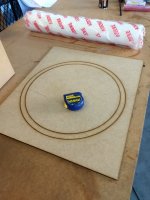 IMG_20210902_130450883.jpg380.2 KB · Views: 81
IMG_20210902_130450883.jpg380.2 KB · Views: 81 -
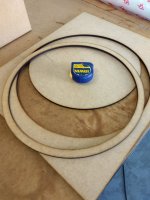 IMG_20210902_130652327.jpg350.3 KB · Views: 55
IMG_20210902_130652327.jpg350.3 KB · Views: 55 -
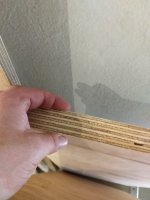 IMG_20210902_151308862.jpg323.1 KB · Views: 63
IMG_20210902_151308862.jpg323.1 KB · Views: 63 -
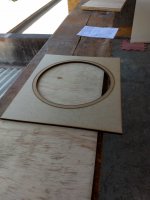 IMG_20210903_103732040.jpg396.9 KB · Views: 59
IMG_20210903_103732040.jpg396.9 KB · Views: 59 -
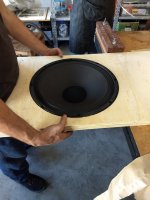 IMG_20210903_134744020.jpg360.4 KB · Views: 61
IMG_20210903_134744020.jpg360.4 KB · Views: 61 -
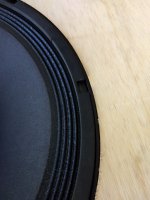 IMG_20210903_134747676.jpg455.7 KB · Views: 59
IMG_20210903_134747676.jpg455.7 KB · Views: 59 -
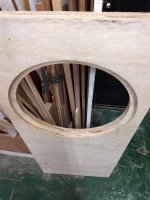 IMG_20210903_135508977.jpg380.3 KB · Views: 63
IMG_20210903_135508977.jpg380.3 KB · Views: 63 -
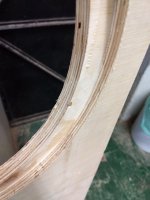 IMG_20210903_135512523.jpg305.9 KB · Views: 61
IMG_20210903_135512523.jpg305.9 KB · Views: 61 -
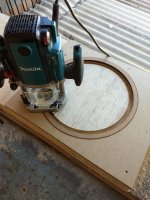 IMG_20210903_142711149.jpg497.8 KB · Views: 62
IMG_20210903_142711149.jpg497.8 KB · Views: 62 -
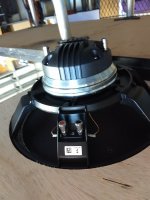 IMG_20210903_150641732.jpg356 KB · Views: 76
IMG_20210903_150641732.jpg356 KB · Views: 76
- Home
- Loudspeakers
- Full Range
- Speakers based on Beyma 15XA38ND
